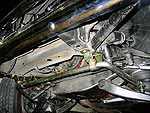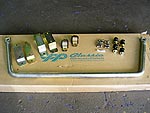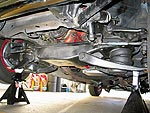
 CPP's front sway bar kit comes complete
with the frame mounts and bushings along with the complete end-link kit
and hardware. Pictured are both the short and tall frame mounts. Since we're
dealing with an airbagged truck, we weren't sure which combination of frame
mounts and end-link spacers would provide the most clearance from the other
components. CPP's front sway bar kit comes complete
with the frame mounts and bushings along with the complete end-link kit
and hardware. Pictured are both the short and tall frame mounts. Since we're
dealing with an airbagged truck, we weren't sure which combination of frame
mounts and end-link spacers would provide the most clearance from the other
components.
 The truck was lifted up to ride height,
and then we jacked it up and placed jack stands under the lower control
arms. The truck was lifted up to ride height,
and then we jacked it up and placed jack stands under the lower control
arms.
|
|
Project Old School: In Control
Adding a Front Sway Bar to an Airbagged Ride
By Jeremy Cook
It's no secret that sway bars are extremely beneficial
to the handling capabilities of old trucks. It's also no secret that most
of the '63-72 GM products did not come with them as standard equipment.
Simply put, there is no easier or more cost effective way to improve upon
the handling of your classic truck.
Also referred to as a stabilizer bar or anti-roll bar,
a sway bar connects the left and right sides of a suspension together. During
cornering, the body tends to lean or fall over. This is what is commonly
referred to as body roll. Connected to each control arm, the pressure applied
from cornering twists the sway bar against the lean, causing a reaction
that produces a lifting force on the outside of the body and a downward
force on the inside of the body. This evens out the pressure generated by
a corner across both tires, which greatly improves handling by making more
traction available to the driver.
The Classic Performance Products' sway bar is stout to
say the least. Thicker than any of the stock units produced for these trucks,
it has an overall diameter of 1.25 inches, is constructed from high-carbon
steel, and comes gold/irridite plated. Using the stock holes in the control
arm, end links with urethane bushings are installed to position the sway
bar. Frame mounting brackets are also provided in the kit, and if they're
there, use the factory holes in the frame. From start to finish, it took
us about an hour to install the CPP sway bar kit. The install is a bit more
involved on Old School due to the airbagged suspension than it would be
on a standard coil-sprung truck. The reason is that you have to make sure
that the sway bar does not interfere with any of the suspension components
throughout the entire suspension cycle--which on this truck is over 8 inches.
So follow along and contact CPP about their front and rear sway bars for
almost any classic truck out there. |


